Drop Bar Hand Positions: an Introduction
Riding a roadbike does not come naturally to everyone, and one particular source of frustration is the drop handlebars. I was frustrated by them too when I first started, and so I hope this illustrated introduction might be of some help. To preface, a couple of things to keep in mind: First, drop bars vary in shape. This post assumes that your bike is fitted with the flat ramp style of bars prevalent today - either the compact type found on most stock road/racing bikes, or the more classic style popular with the twine and shellack crowd (i.e. the Nitto Noodle, Grand Bois Maes, Velo Orange Course). I am also assuming that you are using contemporary "aero" style brake levers, with the brake cables hidden. Note that if you are dealing with a 1970s-80s roadbike (i.e. something like this), the shape of the original handlebars and brake levers will make some of the positions described here impossible. Not everyone agrees on which hand positions are best to use at which times, or even on what the positions are called. This write-up reflects my non-expert personal experiences, informed by local mentours.
Whether you are racing, touring or going on a leisurely ride, what makes drop handlebars special is the variety of hand positions they offer. I consider there to be 5 distinct positions available: The hoods, the hooks, the drops, the tops, and the ramps. Read on for a description of each.
There is a number of ways to hold your hands on the hoods, and this is how I usually do it. The main thing is to actually grip them and not just rest you hands upon them.
3. The Drops

Whether you are racing, touring or going on a leisurely ride, what makes drop handlebars special is the variety of hand positions they offer. I consider there to be 5 distinct positions available: The hoods, the hooks, the drops, the tops, and the ramps. Read on for a description of each.
1. The Hoods
The "hoods" position refers to keeping your hands on top of the rubbery brake hoods, wrapped around them firmly. I think it is fair to say that today this is widely considered to be the standard, neutral position for riding with drop bars. When done correctly, it is extremely ergonomic, distributes the cyclist's weight nicely, and affords optimal leverage for cycling at different speeds. It is also a position from which the brake levers are easily accessible. Some cyclists report that the hoods make them lean forward too much. If this is the case, consider changing your handlebar setup - perhaps raising the bars, getting a shorter stem, or getting compact handlebars (with less distance between stem and hoods). On a properly fitted bike the hoods should feel easy and natural to reach.
There are also different ways to brake from the hoods, and this is how I prefer to do it. Squeezing the brake lever with only two fingers while leaving the rest wrapped around the bars/hoods themselves ensures that my hands won't fly off the handlebars if I go over a bump.
For those accustomed to upright handlebars, the hoods position on a drop bar bike can feel awkward and disconcerting at first and can require some practice to use comfortably. It took me a couple of weeks before I really "got" the hoods, but once I did it's been true love. It's the position I use the most no matter what kind of riding I do. And if you are planning to take part in formal paceline training rides, chances are they will expect you to use the hoods as the standard position - and may even insist that you do so.
2. The Hooks
While often the position shown here is referred to as the "drops," there are actually two distinct drops positions. To differentiate between them, this one is more specifically known as "the hooks." It involves holding on to the parts of the bars that curve outward, with the cyclist's hands directly behind the brake levers. It is a more aggressive and aerodynamic position that the hoods, which makes it especially useful when cycling downhill and attempting to fight wind/air resistance.
The brake levers should be easily reachable from the hooks position. Braking in this manner is more powerful than from the hoods, because it affords greater leverage. It is important to be aware of this, so as not to accidentally slam the brakes when riding at high speeds.
To differentiate from the hooks, this is what I will call the "true drops" position. To what extent the two positions are distinct really depends on the style of handlebars used. On some types of contemporary drop bars, the curvature here is so dramatic that the positions are very different - the true drops being parallel to the ground and the hooks perpendicular. On other drop bars the curve is less defined and it's hard to tell where the hooks end and the drops begin. Either way, the crucial distinction for me is that you can reach the brakes from the hooks, but not from this lower section of the drops.
Both the hooks and the lower drops positions are quite aggressive, and for beginners the crouching posture they put you in can feel scary. While at this stage I am more or less fine riding in these positions, even now I am still not as confident as I could be. Riding downhill in close proximity to others, I sometimes chicken out and stay on the hoods, simply bending my elbows a whole lot to get myself low enough over the bars. In a pinch, that tactic will do - but mastering the hooks and drops is ultimately worth it and I continue to work on it.
4. The Tops
And now, the dreaded tops of the bars... My personal opinion is that the "tops" are bad news for beginners and are to be avoided until after you pick up some road cycling skills. Let me explain: Beginners who cannot use drop bars properly tend to hold their hands on the tops, because this reminds them of mountain bike handlebars and allows them to stay more upright than any of the other positions do. It feels safer. However, this is deeply problematic. First, you cannot reach the brakes from the tops. And if you are too scared to use the other positions, will you really be able to brake quickly and effectively when the situation calls for it? Probably not. Furthermore, drop bars are narrower than mountain bike handlebars, and holding the tops places the rider's hands too close to the stem - not the best position for controlling the bike. Nearly every time I see a beginner on a roadbike lose control of their bicycle, they are holding the tops.
That said, the tops do have their function. Some find this position helpful for climbing, as it opens up the chest and facilitates deep breathing. Also, when doing a long ride it's great to simply have it as yet another position for your restless hands. Personally, I almost never use the tops even in these circumstances, because my hands are uncomfortable. But not everyone has this issue.
5. The Ramps
Finally, there is the rather difficult-to-photograph position called the "ramps," and I have also heard it referred to as the "shoulders." Located between the hoods and the tops, it involves holding the corners of the top portion of the handlebars. In this position the rider is more upright than on the hoods, while maintaining more control of the bike and a more ergonomic wrist position than they would on the tops. I hold my hands in this manner mostly on long rides, for short stretches at a time, when I want to do something different or be more upright for a bit.

All these new positions can certainly be overwhelming. As far as a starting point, I suggest learning to use the hoods well first, then transitioning to learning the hooks/drops. If the pictures here are not enough to help you understand the positions and the braking, ask an experienced cyclist to show you in person and imitate them. I did this some time ago, and it was more helpful than any online tutorial I could have read. And for those riding vintage bikes with handlebars like these and having trouble using them, consider updating the bar setup. You cannot use the hoods with that style of handlebars and levers, and I wish someone told me that when I first struggled with vintage roadbikes 3 years ago.
While drop handlebars are easy and intuitive for some, for others it takes practice to get comfortable with the different positions. My suggestion is to not be intimidated and just keep practicing. If you ask me, it's worth it.


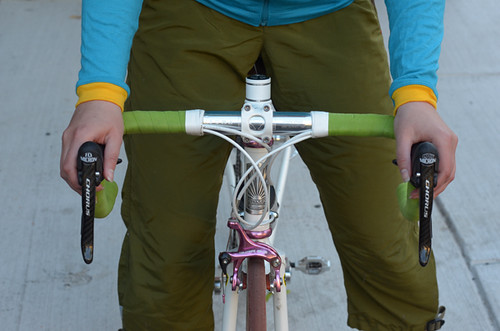
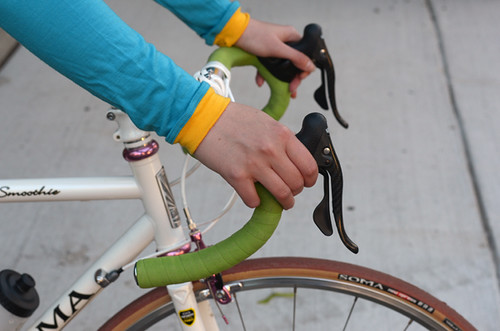
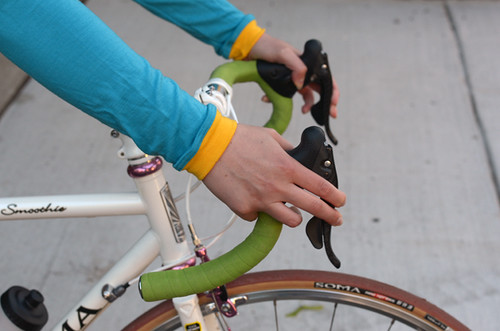
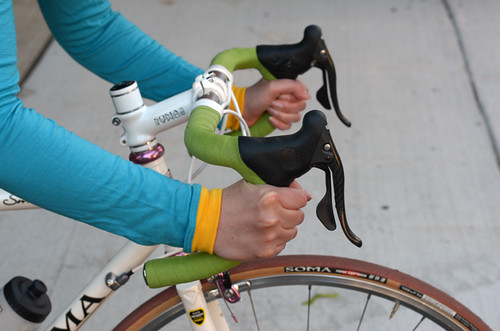
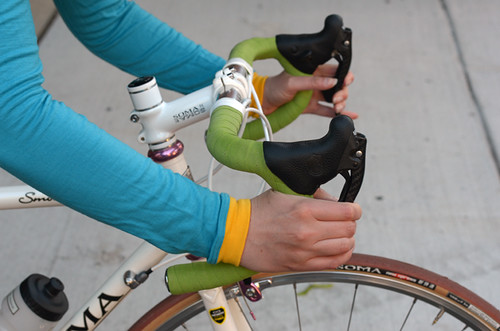
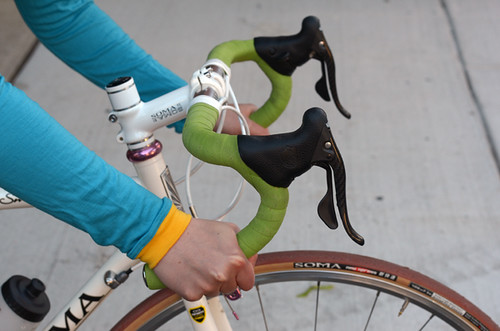
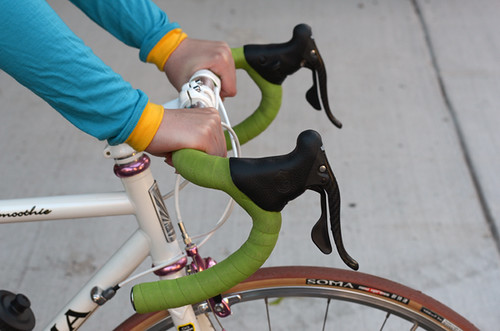
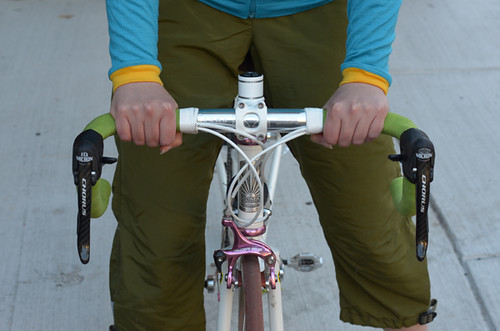
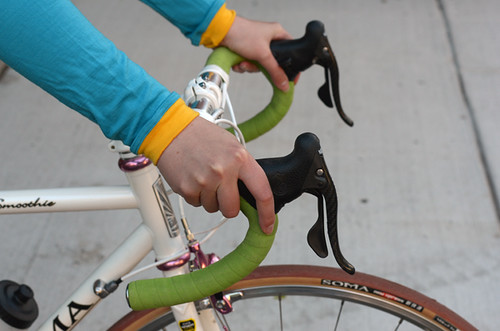
+1 on the more powerful brakes from the hooks, I stupidly advised my sister to try the brakes from the hooks without telling her to do it gently. OTB and a fracture to her knee (but not of the bad kind, she didn't need surgery).
ReplyDeleteVery nice article! I have a '78 Koga Miyata with (what I think are called) safety brakes so I tend to ride the top a lot: http://www.flickr.com/photos/fl1m/4998190218/in/photostream
ReplyDeleteRiding true drops always feels a little weird for me. I also tend to just bend my arms more ;)
Gr. from Cologne,
Pim
PS: I found your blog a while ago but only yesterday added it to my Google Reader... I got som catching up to do on this rainy sunday! :P
Good post. Your explanations are easy to follow and the photos do a good job demonstrating your points.
ReplyDeleteYour aside about paceline mates insisting you hold the bars a certain way underscores why I am completely unable to participate in group cycling activity.
In fact I do normally rest my hands on the hoods much as you shoe (my road bike has traditional levers but the position works out much the same as in your picture.) I'll be darned if someone else insists I ride that way though.
To clarify, it's not the mates. Some training rides are very formal and there is a leader in a coach-type role cycling alongside the riders and shouting instructions. That is part of the ride's appeal, getting advice and training from a senior cyclist in charge. On this type of ride it is assumed we are riding modern bikes and expected that we use hoods when riding most of the time, so that we can continuously pedal and feather the brakes, while all maintaining roughly the same posture. Drops are used when descending, and tops may be used briefly for climbing.
DeleteOf course not all rides are this formal. No one in a club ride has ever told me where to hold my hands unless I specifically ask for advice.
"tops may be used briefly for climbing"
Deletehttp://www.youtube.com/watch?v=fcpkY-ljNws
Michael Rogers talking to Gerald Ciolek: "I thought this was a f*cking Cat 1 climb!"
Notice the hand positions.
Good blog. My favorite position seems to be the shoulders and hoods, using the ramps for short periods. I use the drops when pedaling against headwinds or sprinting.
ReplyDeleteIt's funny you post this now since I just put woodchipper bars on my Surly LHT. I had mustache bars before.
ReplyDeleteWhen I try to ride in the hooks I feel like I'm folded in half which is an extremely uncomfortable feeling. I think that we're going to try raising the bars even higher than they are.
I put cross top brake levers on it. I'm making friends with the brake levers out in front because I like putting my hands on the hoods. They just feel good there, but I still like having my options open to me as far as braking. I also like them for when sitting at a stop light. I can sit up a little and just hold on to those.
An aside: one crucial element in bar comfort is saddle position. Have your saddle properly set back so that your butt is far enough rear-ward that your torso muscles cantilever your upper body over the bar and you won't have excess weight on hands, arms, shoulders. Have your saddle too far forward and you will end up holding yourself up with your arms, no matter how high your bar -- unless you end up with a Dutch bike position.
DeleteWith your saddle properly set up, your bar does not have to be very low to have an efficient, ~45* angle, and you won't feel "folded in half" even when you use the hooks; and the bar/saddle should be so adjusted so that you can use the hooks comfortably at least for a couple of miles.
See: http://www.peterwhitecycles.com/fitting.htm
http://tinyurl.com/82odq4y
And, of course, Beryl: http://tinyurl.com/77hw7pf
Actually moving my seat forward a little helped. But, my bike has a backward sloping seat post anyway. I think it was able to be really far back because I had mustache bars before.
DeleteThank you! This is actually very great, practical advice that most cycling magazines or manuals just expect that you will know.
ReplyDeleteMy first road bike since childhood is sitting right now at the shop getting tuned up (after I purchased it second hand). It is an older-model Gitane mixte, with the brake cables exposed and slightly different brake levers, but I think I should be able to still use this info. Maybe you can also have a tutorial for the older style bikes? Is it possible to hide the brake cables on these older style bikes?
I'll just emphasize that fit and setup are really important in being comfortable on drop handlebars. On my old Cannondale, I was NEVER comfortable riding in the drops. I could ride on the tops and shoulders, or on the hoods.
ReplyDeleteI didn't realize how badly the set-up on that bike fitted me till I rode another bike that was set up better. Riding in the drops on that bike feels really natural and comfortable.
I came to say this! It really cannot be emphasized enough how integral FIT is to the drop bar equation. If you're not comfortable on or very near the hoods, you NEED to swap some parts out. I just went from a VO Course handlebar to a Soma Highway 1, and shortened my reach FOUR CENTIMETERS. I don't think it's terribly common knowledge exactly how much handlebars can vary in their specs. (I am a recent professional-fit convert, can you tell?)
DeleteYeah we're playing around with the adjustments of the woodchipper bars I got and my seat and maybe swapping the hoods. I am sure we will get it just right eventually.
DeleteExcellent descriptions. Although I use drop bars for 90 percent of my riding lately I've taken to using flat (short) mountain bars for hill climbs. I suspect we're all different and prefer different shapes.
ReplyDeleteThe other drop bar I've been experimenting with is the June Bar style where the drops flare widely. When riding with your hand(s) in the ramp position they are, simply put, the most comfortable bars I've ever used. Odd looking, though.
June Bar? When I look that up I get pictures from all over the spectrum. Do you mean like the Salsa Woodchipper bars?
DeleteJune Bars are bars where the drops flare dramatically, and the tops tend to be relatively narrow. Woodchippers are one example, as is the aptly named Soma Junebug. These particular examples, like the on-one midge, are also pretty danged shallow and designed for the dirt (and basically are just re-imaginings of the classic WTB DirtDrop of the 80s); I've seen photos of vintage june bars where the drop is considerably deeper on more road-oriented machines. While most of the contemporary june bars are still designed primarily for trail-folk, more and more road-dwelling humans have been putting them on their bikes.
Delete-rob
Cross-top brakes work well from the tops or ramps.
ReplyDeleteVery helpful guide! I always say that drop handlebars "scare me," but now I realize it's because of what you mention in item 4. Whenever I try a road bike, I grip the "tops" and find I have very little control over the bike. Now I know next time to try the hoods!
ReplyDeleteThe Grand Bois Maes Parallel bars are wonderful; I installed them in place of former favorite Nitto 185s for shallower drop and longer reach and, above all, long, flat ramps with ends of hooks parallel (well, almost parallel) to Mother Earth, as God and nature intended. Highly recommended.
ReplyDeleteAnd no damn' shellac or twine, either!
I love the Grand Bois Maes as well; forgot to link to this post in the text.
DeleteI read (I think it was in Bicycle Quarterly or else on the Compass Bicycles site) that the long, flat ramps were developed before brake levers became hand perches; and if you look at many early levers, they are indeed placed far too low to allow a comfortable support on the "hoods." The long ramp began to disappear as hoods became higher, longer and more padded until, today, the hoods are the principal position and that bar almost a mere mounting bracket.
DeleteI know that, compared to the short, sloped ramp 185s, the Maeses provide an additional hand position forward of the bend but aft of the hoods that is very comfortable.
Noodles are shaped similarly but are considerably deeper; not to mention that they bend backward a bit on the flats. I have 42 Noodles on my Fargo offroad/grocery/touring bike.
Good intro to drop-bar riding... It's especially good that you warn about the tops, although some of the danger of this position can be alleviated with cross-top levers that offer braking from the tops.
ReplyDeleteIn my opinion, you are missing the "upside-down ramps", where you hold the ramps or top curve palms up/forward. Not often used, but it offers a bit of variation.
Also, you should mention the reason that paceline riders )that aren't in the front of the paceline) use the hoods so much: while drafting in a paceline, an aero position isn't that important, but being able to get to the brakes quickly is!
One must not forget that drops require a good deal of flexibility in a persons spine which is not possible for a great many riders.
ReplyDeleteIf a person can get by the flexibility limits the rest is easy.........
Good point.
DeleteI should add that unless one is suffering from a physiological problem that restricts flexibility, one will gradually become more flexible as a result of riding with drop bars. Some might start out just using the hoods, and then after a month of regular riding find that they can also comfortably reach the drops. Alternatively, the bars could be set high to begin with to reduce reach, then lowered gradually as flexibility increases.
In addition to flexibility, "core" strength is also at play here. The more one rides with drop bars, the stronger this muscle group becomes, holding the rider up and thus placing less stress on the hands and requiring less effort to reach.
Overall, even for a healthy person with no flexibility problems it simply takes time for the body to adjust to drop bars. Make sure your positioning is right, and then give it time, practice.
Handlebar choice is not directly related to body position. True, most bikes that come with drops give you lower position than most bikes with regular bars, but that's only because the manufacturers set them up that way. Drop bars can be set higher though, just as regular bars can be set lower.
DeleteRegarding the comments suggesting interruptor levers: I know this is a topic of some debate. Personally I do not recommend them, precisely because having a brake lever there will ensure the person will have no motive to learn the other positions. If a cyclist is most comfortable on the tops and rides in that position most of the time, I think they need to ask themselves - why not just get mountain bike bars? It would be more comfortable for them, and safer. The whole point of drop bars is the drop bar-specific positions, not the tops. The standard position to brake from should be the hoods, and if that's hard to do then something is wrong.
ReplyDeleteI agree that one shouldn't put cross-tops on beginners bars if that makes it harder to learn the other positions...
DeleteBut, the great thing about drop bars is the multiplicity of riding positions, and riding 6-10 hours a day while, for example, touring, it's nice to be able to brake in as many of those positions as possible.
Another thing is, in "super-tuck" (or whatever you want to call it) position for long downhills, where your hands are close to the center of the bars and you are leaning over them, it's nice to be able to brake, especially when fully loaded.
The only times I wish for interrupter levers are when I'm riding on a crowded mixed use path with many pedestrians, some of whom are oblivious to their surroundings. The tops put me more upright, making it easier to scan a wider arc or my surroundings. Too many times, though, a pet, child, or even an adult will just suddenly change course to get in front of me. Not having brakes on the tops, I stay on the hoods for better control all around, though this does narrow my scan arc a bit. That's such a small fraction of my riding, though, that it makes no sense for me to install interrupters.
DeleteLike I said, my woodchippers are my first experience with a drop bar. I have cross top brake levers. It took me less than 10 miles to figure out that I have better control over the bike if I ride with my hands on the hoods. This has led to me figuring out how to make friends with the front brake levers, but I am still glad for the cross tops. I like to have my options.
DeleteI love cross interrupters when riding in the city or on a bike trail or something. I highly recommend them for this purpose: being able to get to your brake levers and stop really quickly when your hands aren't necessarily where they're supposed to be for whatever reason.
DeleteThis was a really nice read. Thanks!
ReplyDelete"I wish someone told me that when I first struggled with vintage roadbikes 3 years ago."
ReplyDeleteNot that you were amenable to hearing such things. I remember strong brifter resistance, now...
I could write a bunch but where you have the levers allows for a comfy hoods position vs. hooks, making that position difficult to hold for extended time and making it difficult to cover the lever.
I was not resistant to brifters; I found them hard to use. Everyone I told this to initially would respond with either "just keep trying" or "you are better off with bar ends anyway." Then Rob Vandermark at Seven/Ride Studio Cafe looked at the brake levers on my own bike, and suggested it's not the brifters I find hard to use but the specific shape of Shimano brifter levers. He said "Here, try Campagnolo - those will feel the same as the Tektro brake levers you like on your bike." I did and they did. Since them I've experimented more and can also use some Sram models, Rival feeling especially comfortable. The Shimano brifters continue to feel awkward though; it's as if they are the wrong shape for my hands.
DeleteMost of the time I do a rampy-hoody fingers splayed over the hooks hold. I'll alternate between that an a more purely ramp or more purely hood hold. I usually do not find the tops, drops, or hooks appealing. After reading this nice introduction I am stimulated to expand my repertoire.
ReplyDeleteYou can find me mostly on hoods and ramps. The tops are fine for climbing but on very steep hills the hoods seem best foot me. Newer Shimano hoods are slightly better than Campy hoods on extremely step pitches. Do you find any differences between Shimano and Campy hoods?
ReplyDeleteNo, you were resistant to them. This was before you even tried them. Look in the archives if you doubt me. I remember recommending them but you hated them for aesthetics. Then you tried them.
ReplyDeleteEvery few years hood shapes change too.
This is really timely....I just took my third ride on a roadbike and used the hoods the whole time. I hadn't really known when I might are about using other positions, since I'm not exactly a racer...
ReplyDeleteGood article! For a fast descent, there is position #6: Hands on top of bar adjacent to stem with body in full aero tuck. Wheeee!
ReplyDelete-t
Have you spent much time on rollers? All these issues of stability, etc, become less so once you are capable of riding rollers no-hands. Think of it as an investment; I did two rounds of half-assed training on rollers at around ages 13 and 18, and it has stuck with me ever since.
ReplyDeleteAttractive set of photographs to illustrate the pece. Very nice.
ReplyDeleteIf you ride with a handlebar that has tops there will be times when your hands are on the tops. And there will be times when you find your hands on the tops and you need to brake. Now. It will make no difference that you have learned to be somewhere else most of the time. You need brakes when you need brakes.
ReplyDeleteThe move from tops to brakes has to be quick, automatic, and positive. Anything less and you're headed for trouble. Enough riders establish this 'skill' on Ride One that it can't be regarded as 'advanced'.
The most obvious reason the brakes can't be reached easily is they're too far away. Yes, flexibility can be acquired over time. In the meantime you need brakes. Flexibility goes away quickly in a hospital.
Anyone who swings a leg over a drop bar bicycle grabs the bars by the tops. This happened a long time before there were mountain bikes.
The tops are the best spot for rough roads. They're the best and safest for taking a drink or eating. As another commenter has already noted, they can be the most aerodynamic (that one is advanced).
Some beginners have a bad habit of locking their elbows. You can do that in several positions, it has the worst effect if you do it while on the tops. The bike and rider can't absorb shock, any little roughness in the road destabilizes the bike. The solution is to unlock the elbows, not to avoid the tops.
I have the VO Chris’ Rando bar on my LHT (love them), set level with the saddle, and I find my hands naturally gravitate to two positions: Ramps about 75% of the time, and halfway between your Hooks and Drops examples almost all the rest of the time. I’ll go onto the hoods when I think I might need to brake (traffic situations, etc. -- this is second-nature from years of motorcycling, where you learn to simultaneously operate the throttle and “cover” the front brake with two fingers in similar situations). The slight flare helps make riding in the drops very comfortable.
ReplyDeleteI once read some advice about climbing hills for those who tend to sit and spin (me!) rather than stand and grind. It said that by going down in the drops and scooting your butt back a bit, you’re able to make use of your glutes more than just your leg muscles. I don’t know if this is true, but it feels right to me (could be placebo…). Crouched down like that, you do probably sacrifice some of the opening of the lungs that you mentioned, though, so a tradeoff…
Charlie
Most of the time I prefer to sit when I climb, and I find what you are describing to work for me as well. If the climb is long, I will sometimes switch my hands over to the tops just for a change, but it's not the position I feel is most effective given my style of cycling.
Delete"they will expect you to use the hoods as the standard position - and may even insist that you do so."
ReplyDeletein my years of riding dangerously i have seen many an off season xc or cx join a paceline/training ride and absolutely smoke the pants off the assorted doctor/lawyer/professional cat1/2/3 wannabes. educate yes...but insist? really???
some additional comments:
*anyone taking a corner at 40 mph on a road bike should be comfortable riding a bike with no hands. balance is a basic skill.
*the hoods are of little use for an emergency stop. imo anyone who has trouble rapidly switching to the drops from any position should consider getting a set of cross levers.
*since climbing is an essential part of road cycling the flats *should* be a frequently used position. the flats are for climbing!
I think the insistence has to do with the participants being relative beginners, not yet accustomed to cycling so close to another's wheel. In that context it makes sense to ensure that everyone is in the same position on the bike. They try to get us riding at the same cadence, too. And no cornering at 40mph on these rides!
DeleteYou mention both the hooks and the drops being quite aggressive. The hooks are for me, if I'm using them I mean business :-) 70% of the time I use mainly the hoods mixed with, to a lesser extent, the ramps for variety. I still find the drops pretty chilled though and far less aggressive than the hooks as I'm generally still pootling, just trying to minimise the effect of a head wind. I'm still pretty lazy and relaxed on the drops, though I will tend to cycle faster than the hoods. Personally, there feels a marked difference in the aggressiveness of the riding posture between the drops and the hooks. Maybe it's just what I'm used to or the way my bike is set up.
ReplyDeleteOh, so that's what the hoods are. :)
ReplyDeleteThe few times I've ridden a bike with drop bars, I always went for the tops, but the distance from the brakes was stressful. Maybe one day I'll give it another try with your tips in mind.
Or get a bike with cross levers, that way you have brake levers on the tops too. The bike I do almost all my riding on is a cyclocross bike and I find the cross levers very useful.
DeleteP.S. Every time I've crashed a drop barred bike I've been riding on the hoods. Mind you when you ride over a patch of black ice in a corner or nail an eight inch deep sharp edged pothole unseen in the dark it really doesn't make much difference what sort of bars you have or how you're using them...
I like whatever it is you are wearing and want to see the whole outfit! Are those MUSA pants?
ReplyDeleteIbex Indie jersey (mens) and Rivendell Musa knickers. The colours look nice together, but it's an eccentric outfit as a whole.
DeleteAn inspired color combination! And so much more appealing than the usual billboard bike costume.
DeleteAn excellent article. Personally I almost always use the hooks when descending as I feel much more in control of the bike. The slightly better aero position is a bonus.
ReplyDeleteUphill it's hoods, ramps or tops. The harder the hill the more likely I am to be on the tops. I find you can get a good pull on the front on the bike from there and for some reason that seems to help. As you say it also opens the chest and I think helps you push down on the pedals.
I very rarely use the drops. I find them uncomfortable for my back, and I don't find any great benefit.
If you see me cycling along my guess would be that I would be on the hoods. Very comfortable and you have all the controls at your disposal.
I think the choice of whether to use the ramps or hoods as your "cruising" position depends a lot on your bike's geometry. My LHT has a longish top tube, and the hoods have me feeling just a tad stretched out. The ramps are where my hands just naturally fall.
ReplyDeleteAlso, I agree with Al that the hooks feel much more secure on a fast downhill. Some people have mentioned using the tops close to the stem for this... aero be damned -- I would find that terrifying! Thanks to gov't cutbacks, the roads here in Mass. are a mess of holes, cracks and patches just waiting to wreak havoc on your front wheel. Using the hooks (and keeping your arms bent and loose) lets you correct for road-induced wobbles much better than the "aero" position would, IMHO.
Charlie
Thanks for mentioning that you feel a bit stretched out on the hoods of your LHT. I too have a LHT and have never been comfortable leaving my hands on the hoods for long periods of time. When I was shopping for the LHT, I discovered that I was in between sizes, and it was suggested to me that I go for the larger size. I've often wondered if that was a mistake. My favorite hand position is on the ramps with quick access to the hoods and brakes when I need it (or so I hope!)
DeleteI agree with those who suggest getting a professional fit when first choosing the bar set-up most appropriate for ones body and style. After that, putting oneself in as many different riding circumstances as possible in order to find that part of the bar which works best. Ride into wind using various gears, climb some hills both in and out of the saddle, descend, ride in a pace line.....Alll of these will introduce one to all areas of a properly fitted set of bars.
ReplyDeleteI agree with those who stress the importance of good fit. Without it, no position is a good position. That said, and as an experienced cyclists, I use the tops very often and although counterintuitive to safety, I put all fingers AND thumb over the top. You will note a nice straight line from elbow to wrist (very little stress on the wrist or tension as can occur with thumb under bar. Also on top you have no torque on your arms or elbows if you remember to keep your arms relaxed. With all of this said, I wouldn't recommend this 'tops' position over rough road and obviously not on downhill grades or while cornering.
ReplyDeleteI'm glad no one ever told me that line about the hoods
ReplyDeletenot being a possible position to ride with vintage cable routing. I was doing the impossible just an hour ago. If you will look at any archive of cycling photos prior to the early 80s you will see that riders rode the hoods without any difficulty. It's not easy to imagine what your problem might have been.
One of the good things about drop bars, if your bike fits correctly, is that you are either on the brakes, or drop onto them naturally. If you're on the tops or ramps ("bends" round here) and let go, you naturally fall onto the hoods. If you're on the drops, you fall into the hooks.
ReplyDeleteOn the tandem/triplet I've experimented with several bar types and shapes, H bars, Midge's, MTB bars with bar ends and always come back to a standard drop bar. It is, for me, the best combination of comfort and safety.
I found that flexibility comes with time on the bicycle. I had difficulties bending into the drops at first, but now find it to be a comfortable change. It also allows you to use different muscles in your legs. The problem I have is that i generally need to raise my neck to see further down the road, which causes some pain in my neck after too long in that aero position.
ReplyDeleteGood article and discussion. I would only add that when riding into head winds the hand position close to the stem with bent arms reduces the torso profile and thus makes you more aero. It's a nice option to the drops. Fast technical descents are what makes one appreciative of the hook position.
ReplyDeleteWell done article. Hopefully this will have a long a fruitful life helping people get used to drop bars.
ReplyDeleteFWIW, if you're hands are of the larger variety, you can setup retro style non-aero brake lever to have both a comfortable hood position and a good break reach from the hooks. I have my old drilled Dia-Compe's setup that way and I've seen photos of other who ride them similarly.
I hope that Soma is treating you well!
There is one more distinct hand position on drop bars, afforded by the newest brake lever shapes like 11-speed Campy, plus the new Tektro and Cane Creek. This is where you are resting only the heel of your hand on the hoods, and wrapping your index, middle and possibly your ring finger around the part of the hood that protrudes upward. You can't do this position in the same way on 10 speed Campy/ old Tektro because the nubs are not big enough. Anyway, it is like being on the hoods but more aero and stretched out. I like this position a lot now and recommend it as a reason to try the new lever shape.
ReplyDeleteAlso, you need interrupter levers if you want to ride your bike while drinking a coffee/ holding a baby/ carrying a tray of cheeseburgers or whatever. I consider them a very useful addition to a drop bar bike that's for city riding.
ReplyDeleteYour grip on the 'hooks' is all wrong. You should be using at most two fingers on the brakes. Using all four like you have done severely compromises your grip on the bars. Using just your index and middle fingers at the end of the levers is best.
ReplyDeleteSolution for the tops brake problem: Fixed gear.
ReplyDelete"Some cyclists report that the hoods make them lean forward too much....consider changing your handlebar setup - perhaps raising the bars, getting a shorter stem, or getting compact handlebars "
ReplyDeleteAfter breaking my wrist, I noticed a fair amount of pain on my repaired hand when I was on top of the hoods on my bike that has a large saddle to bar drop.
My solution: raise the brakes a bit on the bars. With the hoods up, pressure is reduced on my wrist. The set-up with my bar and stem remains unchanged.
Thank you for you advice. I have my first bike and it has drop down handle bars, which I am a bit concerned about xx
ReplyDeleteThanks! I wonder if you or someone could direct me to understanding the positions with relation to weight distribution and elbow angle. I'm new to drop bars and trying to get a comfortable fit for a month-long tour next season. My LBS "fit" me, but it's hard 'cause I don't know what exactly I'm doing... how to hold the bars, if I should feel more seated, or if more weight is expected to be on the pedals at all times, etc. Ultimately, it's especially difficult to find touring-specific info/advice and on a budget!
ReplyDeleteThanks again :)
In my experience in bike commuting, holding the curve gives me more power on a steep climb and faster acceleration on flats. I hold the curve while my thumb is hooked on the brake hoods.
ReplyDeleteI use the "shoulder" or "ramp" whenever I want to accelerate from 0 kph out of saddle. I also use this whenever I need to switch lanes on the road coz I feel it is more stable while I free up one hand to give signal on my act of switching lanes.
I use the drop on bike lanes where the road is clear and having the need for speed haha. I also find this good for descending as it gives you better grip on brake with less hand pains caused by palm being squeezed against the handle bar ouchhh..
The top is for my more relaxed, nice, slow ride and road is not more than 10% steep. This helps me save my neck and head from craining which causes alot of neck pain.
The hood is perfect for busy narrow road. Gives more stable yet aggressive turns while on smaller chain ring..
Very informative and straightforward. Must be the online post with the most complete information of all hands positions on road bikes. Definitely a must read for all like me who want to move from mtb to road bikes.
ReplyDelete